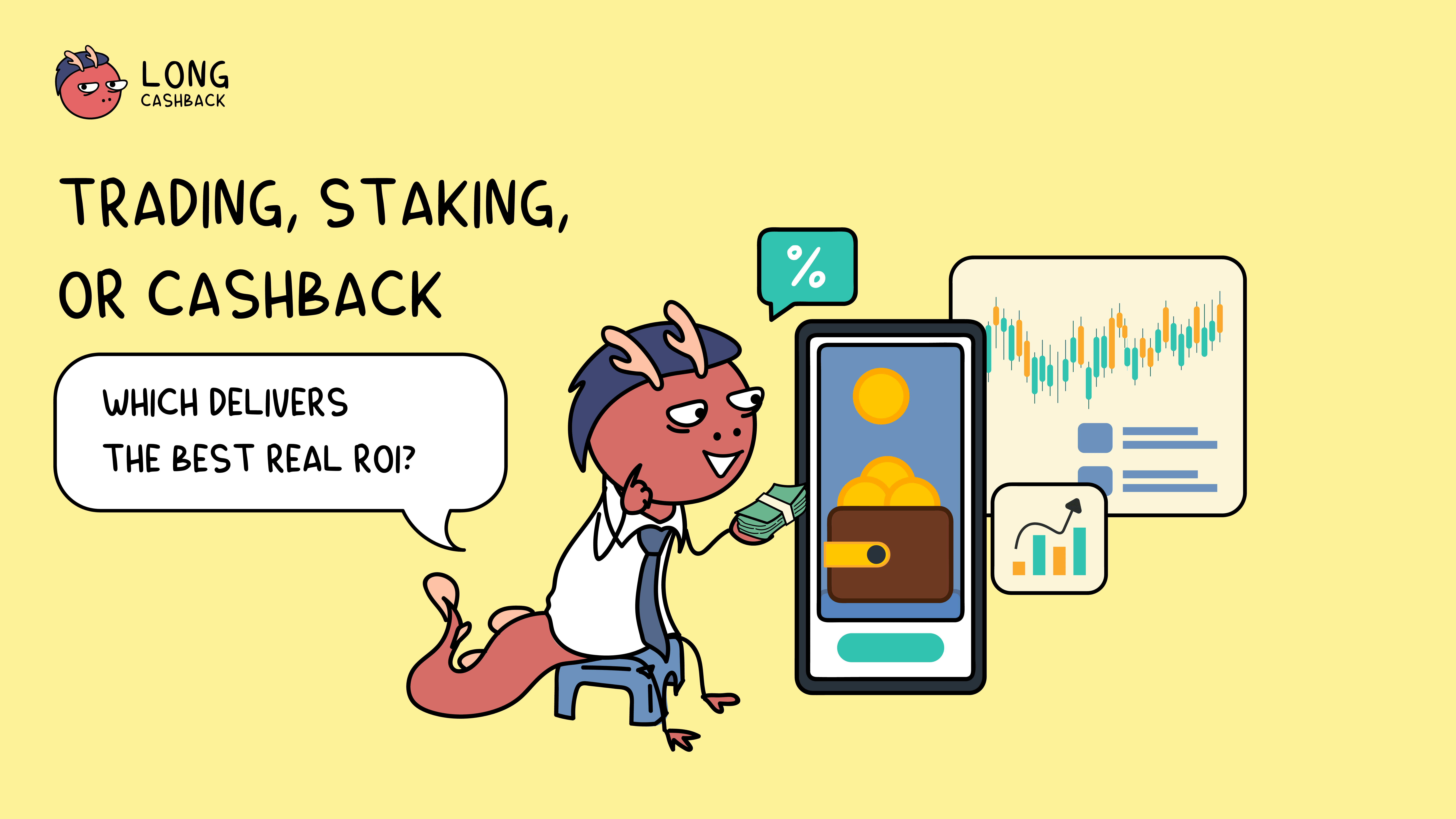November 6, 2025

In today’s crypto landscape, there are three popular ways to generate returns from digital assets: trading (including day trading, futures, and arbitrage), staking (either directly or through service providers), and cashback programs. Each approach offers a different mechanism for profit, risk profile, and cost structure. This article provides a practical ROI (return on investment) comparison among the three, showing when cashback can outperform trading or staking and how to use it strategically to maximize your net gain.
The first step is to recognize how each source of income actually forms.
Trading profits come from price movements.
Staking rewards are earned for helping secure the network or through platform incentives.
Cashback, on the other hand, refunds a portion of your trading fees based on a fixed rate or agreement. It doesn’t create new profits from the market—it optimizes cost. Reducing trading fees directly boosts your net return. When trading profits or staking yields are thin, cashback can make the difference between loss and gain.
Many assume trading offers higher ROI, but data tells a different story. Studies show most retail traders, especially those using leverage tend to underperform. Transaction fees, slippage, and financing costs often eat into gross profits. Add taxes, spreads, and hidden costs, and net ROI shrinks fast.
This is especially true for high-frequency strategies: more trades mean more fees. Without careful cost control, even a strategy with a positive edge can end up unprofitable.
Fee structures also vary by exchange and user tier. Major exchanges offer discounted rates for VIP users, but for most regular traders, maker/taker fees remain significant. Understanding fee tiers and optimizing trade execution can drastically impact your real ROI.
Staking tends to deliver more stable returns than trading, but it comes with trade-offs. For large-cap tokens like ETH, real APYs are now moderate typically just a few percent annually. Smaller altcoins may offer higher yields but carry substantial depreciation risk.
Overall, staking suits those seeking passive income with lower volatility, though the absolute return may not be as high as some expect. Current market surveys show top-asset staking yields hovering around low-to-mid single digits, depending on platform and token. On a monthly basis, this translates to modest ROI compared to active trading.
Cashback isn’t a profit strategy, it’s a cost reduction mechanism. When used right, it directly and measurably boosts net ROI. The formula is simple:
Net Profit = Gross Profit − Fees + Cashback.
For strategies with thin margins (like arbitrage, scalping, or grid trading), cashback can make up a large portion of total PnL. A 20–50% refund on trading fees can easily flip a breakeven result into profit. That’s why many professional desks and high-frequency traders treat cashback as an essential part of their model.
When comparing monthly ROI for the same capital, the contrast becomes clear.
For example, imagine a trader with $300 in gross profit but $250 in trading fees. With a 50% cashback (receiving $125 back), net profit rises from $50 to $175 - a 3.5x improvement in actual ROI.
Beyond that, cashback improves capital efficiency. Rebates arrive in stablecoin, which can be reinvested immediately, compounding returns over time. When reinvested monthly, cashback can outperform some staking yields, especially for active traders.
Cashback makes the most sense for active traders, those with high volume or tight-margin strategies like scalping, arbitrage, or grid trading. If you’re a long-term holder with minimal trading activity, staking might be a better fit.
Transparency also matters. Some platforms issue cashback in locked or volatile tokens, which complicates ROI tracking. Programs paying in stablecoins are far more reliable for measuring true returns.
Among existing cashback models, Long Cashback stands out with up to 50% rebates, automatic payouts, and support for top-tier exchanges. For high-frequency traders, it’s simple yet effective: sign up once, connect your accounts, and cashback is automatically sent to your wallet each month.
Its transparent dashboard lets you cross-check data against your exchange’s fee CSVs, making real ROI tracking effortless. If optimizing your trading cost is your next step, Lóng offers a straightforward way to make every trade work harder for you.
There’s no one-size-fits-all answer. Trading can yield high ROI but involves greater risk and cost. Staking offers consistent but moderate returns. Cashback isn’t a profit engine, it’s a precision tool for cost optimization.
When paid transparently in stablecoins, cashback can significantly lift your net ROI, sometimes more than refining your trading edge itself.
If you’re an active trader, joining a reliable cashback program should be a priority. Choose one that supports multiple exchanges, pays in stablecoins, and tracks rebates clearly. Long Cashback is a solid example worth testing, see how much it can boost your real trading performance.

Compare the advantages and disadvantages of “bot trading” and “copy trading” for earning rebates when trading digital assets, helping investors choose the most profitable approach.
long cashback crypto cashback bot trading copy trade
Tham gia ngay, săn Airdrop – trúng thưởng tới tấp cùng Bybit
BYBIT cashbackcrypto futurestrading
In the crypto market, trading, staking, and cashback are three common ways to earn from digital assets. This article compares their real ROI, highlights when cashback can outperform the others, and explains how traders can optimize their net returns.
ROI cashbackcrypto staking tradingfutures